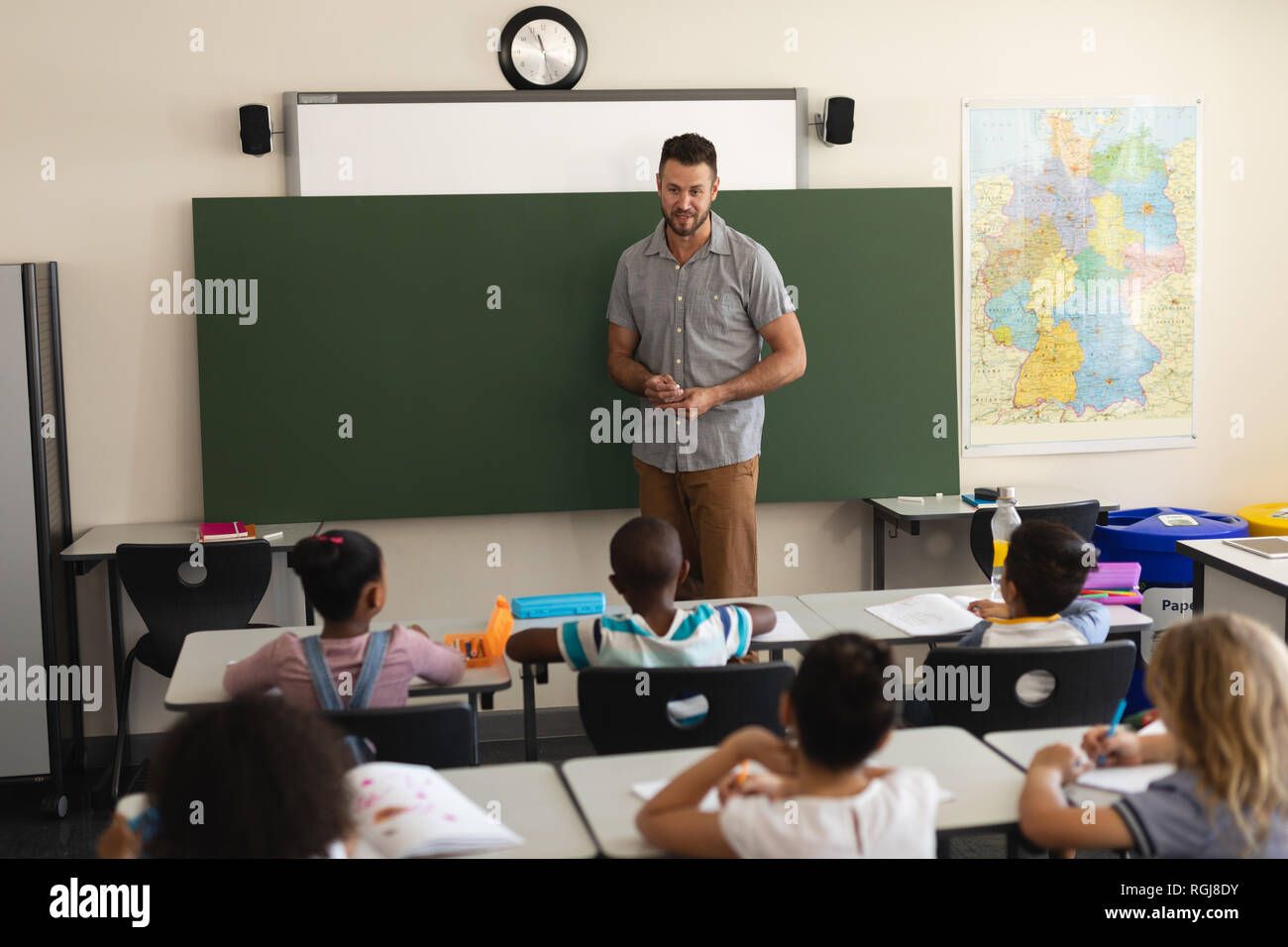Expert Tutors Offering Primary Science Tuition Singapore for All Grades
Expert Tutors Offering Primary Science Tuition Singapore for All Grades
Blog Article
A Comprehensive Overview to the Different Discovering Techniques in Primary Science Direction
The exploration of varied learning methods in key scientific research instruction provides an opportunity for instructors to boost student interaction and understanding dramatically. By analyzing hands-on understanding techniques, inquiry-based methods, and collaborative strategies, we can recognize effective techniques that cater to different finding out designs.

Hands-On Understanding Techniques
Hands-on understanding techniques play a crucial function in main science guideline, involving students in active exploration and testing. These approaches permit learners to interact straight with phenomena and products, promoting a much deeper understanding of clinical ideas. By utilizing manipulatives, models, and real-life experiments, teachers develop a setting where trainees can observe, assume, and evaluate their concepts.
Such methods not only enhance understanding however likewise grow critical reasoning and analytical skills. When trainees take part in activities like building basic devices, growing seeds, or carrying out chain reactions, they are encouraged to ask inquiries and look for responses through their own monitorings. This experiential technique aids to debunk complicated scientific concepts, making them a lot more accessible and relatable.
In addition, hands-on understanding advertises partnership among peers, as pupils frequently work in groups to perform experiments or share findings. This teamwork not just enhances their understanding experience however additionally establishes vital social abilities. Eventually, integrating hands-on strategies in key science instruction fosters a long-lasting love of knowing and interest about the environment, laying a strong foundation for future scholastic quests in scientific research and past.
Inquiry-Based Understanding
Inquiry-based understanding is an educational strategy that urges students to ask concerns, investigate sensations, and build their own understanding of clinical concepts. This technique moves the emphasis from conventional teacher-led direction to a much more student-centered experience, where learners take the effort in their instructional trip. By fostering inquisitiveness, inquiry-based learning promotes much deeper involvement with the material, enabling trainees to discover subjects in a meaningful context.
In method, this strategy frequently includes hands-on experiments, monitorings, and essential thinking activities that align carefully with the clinical approach. Pupils are urged to formulate hypotheses, design investigations, and examine information, which grows essential skills such as problem-solving and analytical reasoning. The function of the teacher in this structure is to promote expedition, leading pupils via the inquiry procedure while urging independent idea and cooperation.
Moreover, inquiry-based learning supports a feeling of possession over the understanding procedure, encouraging trainees to go after understanding proactively. This approach not just improves understanding of scientific concepts however also fosters a long-lasting love for learning, equipping pupils with the abilities needed to navigate a progressively complicated globe.
Collaborative Understanding Approaches
Joint understanding methods empower pupils to participate in meaningful interactions with peers, cultivating a shared obligation for their educational results. In main science guideline, these techniques motivate learners to interact to explore scientific ideas, address issues, and conduct experiments (primary science tuition Singapore). By joining team tasks, students can utilize diverse point of views, enabling for richer understanding and retention of clinical understanding
One secret facet of joint knowing is the focus on communication skills. Students have to articulate their thoughts, listen proactively to others, and bargain ideas, every one of which are vital proficiencies in both real-world and scholastic here contexts. This social interaction not only improves their understanding of clinical concepts yet also advertises team effort and problem resolution skills.
Furthermore, collaborative knowing typically leads to boosted inspiration and engagement. They are extra most likely to take possession of their knowing journey when students see the value of their payments within a group. Teachers can facilitate this procedure deliberately organized team jobs that straighten with curriculum goals while supplying guidance on reliable partnership strategies. On the whole, including collective learning techniques in primary scientific research direction grows a vibrant understanding atmosphere that prepares trainees for future academic and social difficulties.
Innovation Assimilation in Science
The combination of innovation in primary science direction improves discovering experiences by supplying innovative tools and resources that sustain various mentor methods, including collaborative understanding - primary science tuition Singapore. Making use of electronic platforms, simulations, and interactive applications permits students to involve deeply with clinical ideas, facilitating an extra hands-on strategy to learning
Digital labs, as an example, make it possible for learners to perform experiments securely and efficiently, advertising inquiry-based understanding. These devices can simulate real-world scientific scenarios, enabling trainees to picture intricate procedures that would be difficult to reproduce in a typical class setup. Additionally, technology cultivates communication and cooperation amongst students, as they can share searchings for and collaborate on jobs via online systems.
Additionally, multimedia presentations and go to website academic video clips can improve lessons by dealing with diverse discovering designs, making abstract principles more available. Information evaluation devices additionally empower students to collect and translate scientific information, enhancing critical believing skills. Generally, the critical unification of modern technology in primary science instruction not only improves interaction however likewise prepares trainees for a technically innovative culture, furnishing them with necessary abilities for future clinical undertakings.
Set Apart Guideline Approaches
Set apart guideline approaches are crucial for resolving the varied demands of learners in primary science education. These approaches make it possible for educators to tailor their teaching methods to accommodate differing abilities, passions, and discovering styles within the class. By utilizing distinguished direction, teachers can create a comprehensive atmosphere that promotes engagement and boosts understanding of clinical concepts.
One effective approach is to make use of versatile grouping, which permits trainees to team up with peers at comparable ability levels or with varying perspectives. This technique urges peer understanding and promotes crucial reasoning. In addition, supplying choices in projects can encourage pupils, enabling them to select tasks that resonate with their interests while still meeting curricular goals.
Additionally, incorporating tiered projects is an additional useful method. Deliberately tasks with varying levels of complexity, instructors can make sure that all pupils are appropriately challenged, despite their efficiency. Utilizing formative analyses about his to gauge recognizing further enables educators to change their educational techniques dynamically, ensuring that each learner obtains the assistance they need.
Inevitably, applying distinguished instruction techniques in main science education not only enhances student learning results but additionally cultivates a passion for science, preparing students for future academic pursuits.

Final Thought
In recap, effective primary scientific research direction necessitates a multifaceted strategy that incorporates hands-on discovering, inquiry-based methods, and collective strategies. The assimilation of modern technology and separated instruction better deals with diverse understanding designs, promoting an environment helpful to exploration and vital reasoning. By applying these approaches, instructors can boost student engagement and understanding, eventually supporting a lifelong passion for scientific research and questions. Such comprehensive techniques are important for creating informed and curious future researchers.
The exploration of diverse knowing techniques in key scientific research guideline presents an opportunity for educators to improve trainee interaction and understanding dramatically.Hands-on learning techniques play a pivotal role in primary science instruction, engaging students in energetic expedition and experimentation.Inquiry-based discovering is an instructional method that motivates pupils to ask questions, investigate phenomena, and build their very own understanding of scientific concepts.Collective knowing approaches equip trainees to involve in significant communications with peers, fostering a common responsibility for their academic end results. Overall, integrating collective learning techniques in key scientific research guideline grows a vibrant knowing environment that prepares pupils for future scholastic and social difficulties.
Report this page